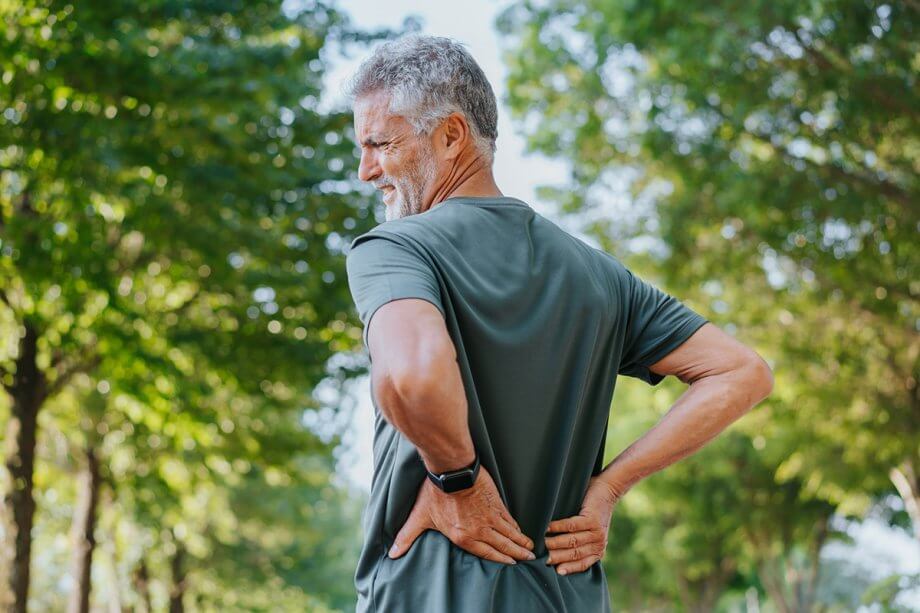Lower back pain, also known as lumbar back pain, is extraordinarily common. According to the World Health Organization (WHO), lower back pain is the most common musculoskeletal condition in the world and is the number one cause of disability around the world. Unfortunately, therefore, the majority of people will experience lower back pain at some point in their lives. But, there are measures you can take to reduce the likelihood that you’ll need surgery. Read on for best practices for preventing lower back pain.
Why is Low Back Pain So Common?
Low back pain is common largely due to the anatomy of the spine. Consider that the lower back only has five vertebrae, and sustains the brunt of the body’s stress and strain. It is responsible for keeping us upright, bearing all of the weight of the upper body, and connecting the spine to the pelvis. These factors, coupled with the fact that the spine weakens as we age due to wear and tear, and degenerative conditions such as spinal stenosis, osteoarthritis, or injury, are the main reasons that people develop low back pain.
Preventing Lower Back Pain: Tips and Tricks
No one is immune from the effects of aging. Moreover, no one can predict accidents such as falls, sports injuries, or vehicular accidents. But, there are numerous things we can do to keep our backs as strong and healthy as possible for as long as possible.
- Develop Strong Core Muscles
Our lower back bears a great deal of stress from lifting, and supporting the upper body. To alleviate some of the strain on the bones, muscles, joints, and tendons of the back, focus on building strong core muscles. The core muscles include the hip and trunk muscles as well as the abdominal muscles.
- Maintain a Healthy Weight
Excess weight puts additional strain on the bones and muscles of the lower back. This can lead to tilting of the spine, which often contributes to lower back pain.
- Sit up Straight
A hunched-over posture places additional strain on the discs of the lower back. If you tend to hunch at your computer or while looking at your phone, take periodic breaks to stand up straight and walk around.
- Stretch and Then Stretch Some More
Daily stretching is underrated. Stretching keeps your muscles loose so that they are less likely to spasm and strain your joints.
- Lift Carefully and Correctly
When lifting any object, be sure that you’re using your legs in conjunction with your back. Bending at the waist to lift something, particularly something heavy, is one of the leading causes of low back strain, sprain, and other injuries.
- Exercise Regularly
Regular exercise doesn’t have to be strenuous. It doesn't even require a gym membership. Daily, brisk walking is all that is needed to promote good blood circulation. Sufficient blood flow is essential to prevent low back pain, as it ensures that the muscles, tendons, and ligaments get all of the nutrients and oxygen they need.
- Maintain Good Overall Health
Drinking plenty of water, getting sufficient sleep, avoiding excess alcohol and all nicotine, and staying active is an excellent way to stay healthy. While anyone can suffer an injury to the back, or develop a degenerative disease, those who are in better overall health are likely to recover better and faster from pain, injury, or surgery if needed.
Frequently Asked Questions about Pain Management
Can I self-refer for pain management?
No. At the American Pain Institute, we require a physician’s referral to book your appointment.
Will insurance pay for pain management therapies?
All policies have unique exclusions and allowances. Our team is happy to file claims on your behalf. Many treatments are covered by the majority of insurance plans. Please note you will be responsible for your co-payment at the time of service and for balances that are not approved by insurance.
Treatment for Low Back Pain in New Hampshire
The good news for those suffering from low back pain is that most people will not require surgery to treat the pain. Nonsurgical pain management treatments for low back pain may include physical therapy, alternative therapies, and a variety of injections to alleviate pain. To schedule an appointment with Board-Certified Anesthesiologist and Pain Management doctor Joshua Greenspan MD, call 603-766-8500 .

